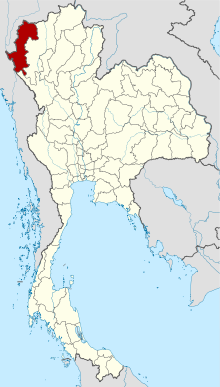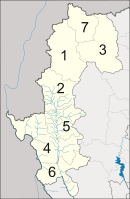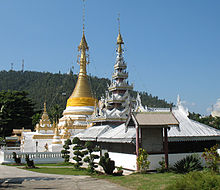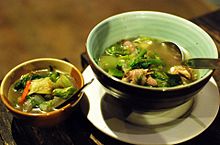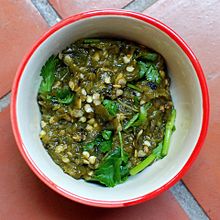- Mae Hong Son Province
-
Mae Hong Son
แม่ฮ่องสอน— Province — 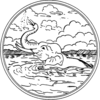
SealMap of Thailand highlighting Mae Hong Son Province Country  Thailand
ThailandCapital Mae Hong Son Government – Governor Kamthon Thawonsathit (since October 2009) Area – Total 12,681.3 km2 (4,896.3 sq mi) Area rank Ranked 8th Population (2009) – Total 248,748 – Rank Ranked 72nd – Density 19.6/km2 (50.8/sq mi) – Density rank Ranked 76th Time zone Thailand Standard Time (UTC+7) ISO 3166 code TH-58 Mae Hong Son (Thai แม่ฮ่องสอน) (also Maehongson, Mae Hong Sorn or Maehongsorn) is one of the northern provinces (changwat) of Thailand, and at the same time the westernmost. Neighboring provinces are (from north clockwise) Shan State of Myanmar, Chiang Mai and Tak. To the west it borders Kayin State and Kayah State of Myanmar again. It was formerly called Mae Rong Son (also Maerongson, Mae Rong Sorn or Maerongsorn).[1]
Mae Hong Son (The City of Three Mists) is nestled in a deep valley hemmed in by the high mountain ranges of the Shan Hills, Mae Hong Son has long been isolated from the outside world. It is the most mountainous province in Thailand and composed of a total of 13, 814 square kilometers. It is virtually covered with mist throughout the year, the name refers to the fact that this terrain is highly suitable for the training of elephants. Former governors of Chiang Mai used to organize the rounding up of wild elephants which were then trained before being sent to the capital for work. Today, Mae Hong Son is a "dream destination" for visitors.[citation needed] Daily flights into its small airport bring growing numbers of tourists, attracted by the natural scenery, numerous hill-tribe communities and soft adventure opportunities.
Contents
Location and boundaries
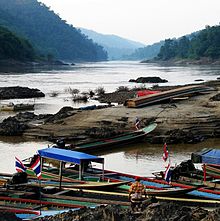 The Salween river at Mae Sam Laep, Amphoe Sop Moei. Left is Myanmar.
The Salween river at Mae Sam Laep, Amphoe Sop Moei. Left is Myanmar.
Mae Hong Son Province is situated in northern and northwestern Thailand at 17° 38′ - 19° 48′ N and 97° 20′ - 98° 39′ E and furthest from Bangkok in the north at a distance of approximately 924 km. It boasts an area of approximately 12,681.259 km² or around 7,925,812.5 rai, which is third largest in Northern Thailand and seventh largest in the country. It is approximately 250 km from north to south and approximately 95 km from east to west.
To the north and west it connects to a total of three states in the Union of Burma, namely the southern portion of Shan State; Kayah State and Kawthoolei State via the West Thanon Thongchai Mountains and the rivers Salween and Moei which serve as natural boundaries between the countries. To the south it connects to the district of Tha Song Yang, Tak via the rivers Yuam and Ngao which serve as a provincial boundary. To the east it connects to the districts of Wiang Haeng, Chiang Dao, Mae Taeng, Mae Chaem, Hot and Omkoi in Chiang Mai Province via the Central and East Thanon Thongchai mountain ranges that serve as a boundary line between the two provinces.
Every district in Mae Hong Son Province shares a common border with the Union of Burma approximately 483 kilometres in total length. Of this, approximately 326 kilometres is land and 157 kilometres are rivers (not counting the Salween, 127 km, and Moei, 30 km).[2]
Geography
Climate data for Mae Hong Son Month Jan Feb Mar Apr May Jun Jul Aug Sep Oct Nov Dec Year Average high °C (°F) 30
(86)33
(91)36
(97)38
(100)35
(95)32
(90)31
(88)31
(88)32
(90)32
(90)31
(88)29
(84)33
(90.5)Average low °C (°F) 14
(57)14
(57)17
(63)22
(72)24
(75)24
(75)24
(75)23
(73)23
(73)22
(72)19
(66)16
(61)20.2
(68.3)Precipitation mm (inches) 8
(0.31)2
(0.08)5
(0.2)50
(1.97)180
(7.09)185
(7.28)213
(8.39)252
(9.92)199
(7.83)115
(4.53)37
(1.46)15
(0.59)1,261
(49.65)Avg. rainy days 1 1 1 5 17 22 25 26 20 13 5 2 138 [citation needed] Most of the areas of Mae Hong Son Province are complex mountain ranges and likely still pristine virgin forest. Of the approximately 6,976,650 rai of national forest reserves, 88.02% is thought to be pristine virgin forest. Mountain ranges run unbroken from north to south with important mountain ranges being the Lao-territory mountains located on the northernmost portion of the province that serve as a boundary between Thailand and the Union of Burma and the Thanon Thongchai Mountains which are in fact three adjoining ranges, the East, West and Central Thanon Thongchai mountain ranges respectively; the West Thanon Thongchai Mountains serve as a boundary between Thailand and the Union of Burma. The mountains in the east of the province serves as the boundary between the provinces of Mae Hong Son and Chiang Mai. The tallest point is Mae Ya Peak (ยอดเขาแม่ยะ) of the East Thanon Thongchai Mountains in the Pai District in the province's northeast, at 2005 metres above sea level.[3]
History
 Panorama of the rice paddies and mountains south west of Mae Sariang
Panorama of the rice paddies and mountains south west of Mae Sariang
It is believed that the lands of Mae Hong Son had already been settled before the arrival of Lord Kaeo of Ma (เจ้าแก้วเมืองมา; Chao Kaeo Mueang Ma) and his consequent resettlement in the area. However, there is no evidence as to what time or period they arrived, nor of their migrations thereafter. These former inhabitants have left evidence of their activity in the area and are believed to have been Lua, or Lawa, hill tribes' people. Evidence to date includes gravesites and discarded housing structures such as those found in the vicinity of the Mae Hong Son Municipal Hall (หอประชุมเทศบาลเมืองแม่ฮ่องสอน), nowadays the Morning Markets (ตลาดโต้รุ่ง) and Dharma School (โรงเรียนปริยัติธรรม), by the Chong Klang (จองกลาง) and Chong Kham (จองคำ) monasterial compound. These first settlers were likely depopulated by either malaria or war, with survivors then dispersing out to safer areas.
The old, pre-Rattanakosin lands of Mae Hong Son was merely a collective of forest settlements without a central government, with Shan peoples who had crossed into the area from beyond the frontier with the Union of Burma in search of a means to find food, working in agroforestry and joint plantations as the seasons permitted. During this period the area was significant only as a passage for Burman troops marching on the capital at Ayutthaya or to the various Siamese capitals of Northern Thailand.
Mae Hong Son historical records state that in the year 1831, which corresponds to the reign of King Nangklao (Rama III) of the Rattanakosin Period, in the mueang of Phing Nakhon (เมืองพิงค์นคร) known today as Chiang Mai, in the lands of the Kingdom of Lannathai, was Phraya Chiang Mai Mahawong (พระยาเชียงใหม่มหาวงศ์), who was later to ascend to the rank of Phra Chao Mahottraprathet Racha Thibodi (พระเจ้ามโหตรประเทศราชาธิบดี), who knew that to the west of Chiang Mai, which meant the lands of today's Mae Hong Son, was a geography of tall mountains and dense forests inhabited by a myriad of forest creatures of which wild elephants in particular were in great abundance, and thus ordered Lord Kaeo, who was a relative of his and a local military chief and governor, to herd these elephants out into the custody of mahouts, to survey the feasibility of this task on such western frontierlands and to be of further service in the capturing of the elephants so that they might be trained for labour thereafter.
Lord Kaeo assembled his troops, lure-elephants and mahouts and set out from Chiang Mai, bound for a shortcut which entered northeast along a brook leading them to complex mountain ranges. After a short trip they arrived in the hamlet of Wiang Pai (เวียงปาย), or Amphoe Pai as it is known today. Here, Kaeo and his commission stopped a while before resuming their expedition. They then headed south to find a shortcut along the Pai River, so that they might ascend into the mountains once more.
After travelling for a longer period this time, they then headed back towards the Pai River. On arrival, they found a tiny community living in the area, either Shan or otherwise Tai, with hamlets along the Pai River amid vast areas of thick, virgin forest. Lord Kaeo deemed this location most suitable to build a village, with ample land to extend the scope of the village in the future and abundant saltlicks nearby the houses for boars; all one required in maintaining a successful village.
Lord Kaeo then rehabilitated the various scattered settlements into a single village and had them elect a leader referred to as a heng (เหง); Phakamong (พะก่าหม่อง), a Shan, was thus elected as the village heng. (The village elder, or kamnan, ruled over the village, and it was then named Ban Pong Mu, or Village of the Boar Saltlick (บ้านโป่งหมู). It later became Ban Pang Mu (บ้านปางหมู ), Tambon Pang Mu, Amphoe Pang Mu, Changwat Mae Hong Son. Lord Kaeo, together with Phakamong, then travelled further south with a number of their elephants in tow into the realm of what is today's Mae Hong Son. Finding it a suitable location with a stream flowing by from east to west into the Pai River and a second brook running further north, he decided it would be most fitting to establish his elephant training camp there along with a residential base for personnel. Subsequently, he constructed an elephant pen on the banks of the stream and the area became another village for the Shan settlers, although with a smaller population than that of Ban Pong Mu. After Lord Kaeo had captured the satisfactory quota of elephants and had trained them as instructed, he decided to head back, and so elected the son-in-law of Phakamong, Saenkom (แสนโกม), as the kang (ก้าง) or village chief to oversee the village and it was then that the village was named Ban Mae Rong Son, or Village of the Elephant Training Camp Bayou (บ้านแม่ร่องสอน); later, the name Mae Rong Son was corrupted to Mae Hong Son, as pronounced in the brogue of the Lannanese (initial r's are often pronounced as h's), and the aforementioned second brook that ran north was named Lamnam Pu (ลำน้ำปุ๊) on finding water there splashing up from the earth (lamnam refers to any body of flowing water; pu is the sound produced when throwing a stone or brick into the mud or against a soft substance).
The village of Mae Rong Son flourished and prospered and Shan began migrating there in increased numbers. Aside from this wave, in around the year 1856 there arose much political unrest on the western banks of the Salween River which furthered the influx of peace-loving Shan, and again in 1876 when war broke out between the blood-princes of the principalities of Nai (เมืองนาย) and Mok Mai (เมืองหมอกใหม่) respectively. Prince Kolan (เจ้าฟ้าโกหล่าน) of Mok Mai, unable to sustain the battle, moved his family to live with Saenkom in Mae Rong Son along with his wife Nang Khiao (นางเขียว), their son Khun Long (ขุนโหลง), their grandson Khun Ae (ขุนแอ) and their granddaughters, Chao Nang Nu (เจ้านางนุ) and Chao Nang Mia (เจ้านางเมี๊ยะ).
By 1874, with the village of Mae Rong Son having become a huge community with a constant influx of migrants and so it was agreed that it should change its status to that of a fully fledged mueang. Lord Inthawichayanon, Lord of Chiengmai, thus elected a Shan named Chankale (ชานกะเล) to be its first partasakti (บรรดาศักดิ์; bandasak; somewhere between a count, in non-prerogative terms, and a governor) and bestowed on him the title of Phaya Singhanat Racha, or Sacred Voice of the King of the Singh (พญาสิงหนาทราชา), who would govern the mueang of Mae Hong Son from 1874, corresponding to the Rattanakosin Period of Rama V.
Later, in 1884, after caring for the mueang of Mae Hong Son for a decade, Phaya Singhanat Racha died. The next ruler was Chao Nang Mia, who ruled for seven years, bringing the realm to further great prosperity before passing away in 1891.
The next Lord of Mae Hong Son was Tho (โท้ะ), referred to as Pu Khun Tho or Old Man Tho the Mandarin (ปู่ขุนโท้ะ), who was made partasakti with the title Phaya Phithak Sayam Khet, or Lord Protector of the Fertile Soils of Siam (พญาพิทักษ์สยามเขต). He governed the mueang of Mae Hong Son between 1891 to 1905 before his own passing that year.
The next figure to rule as Lord of Mae Hong Son was Khun Lu (ขุนหลู่), the son of Pu Khun Tho, who reigned in his place as partasakti with the title Phaya Phisan Hong Son Buri, or Lord of the Metropolis of Hong Son Most Vast (พญาพิศาลฮ่องสอนบุรี). He governed over Mae Hong Son between the years 1905 to 1941. To follow was a period of change in government administration and there would be no more such ranks and titles.
In 1890, during the reign of Rama V of Bangkok, Phraya Si Sahathep (พระยาศรีสหเทพ), Plat Thun Chalong (ปลัดทูลฉลอง) of the Ministry of the Interior, completed an inspection tour of the cities in the Northwestern Mandala (see also Mandala (Southeast Asian history) and Mandala for perspective) and consulted with High Commissioner Phraya Ritsaratchakit (พระยาริศราชกิจ ข้าหลวงใหญ่), who oversaw the Northwestern Mandala, to organise a new order of governance, namely, he would incorporate the partially independent city-states of Mae Hong Son, Khun Yuam (เมืองขุนยวม), Yuam (เมืองยวม) (Mae Sariang) and Pai into a single unit of government to be called the Boriwen Chiang Mai Tawantok, or Shire of Western Chiang Mai (บริเวณเชียงใหม่ตะวันตก), and placed the government of the shire (which was now comparable to that of a single mueang) at Khun Yuem by appointing Nai Mot (นายโหมด) as shire reeve (as stated by the Minister for the Interior on July 11, 1901).
In 1903, the seat of government was moved from Khun Yuam to Yuam and the administrative division was renamed from Western Chiang Mai (บริเวณเชียงใหม่ตะวันตก) to Northern Phayap (บริเวณพายัพเหนือ). In 1910, a royal decree saw the merging of Mae Hong Son, Yuam and Pai into a fourfold realm alongside the Mandala of Phayap, and moved the administrative capital to Mae Hong Son with Phraya Sonsurarat (Plueng) (พระยาศรสุรราช (เปลื้อง)) as the first Governor of Mae Hong Son Province. In 1933, governance as a territory was ceased and then reinstated as a constitutional administrative government as per the Constitution of the Kingdom of Thailand as remains in place today.[4]
Demographics
63% of the population in the province are members of the hill tribes, among them the Hmong, Yao, Lahu, Lisu, Akha and Karen. Another big ethnic group are the Shan. The province has the lowest population density of all the provinces of Thailand.
Symbols
The provincial seal, Rup chang nai thong nam (รูปช้างในท้องน้ำ), is a reference to the training of wild elephants to be able to take orders in battle and for various types of animal labour.
The decision behind the selection of Rup chang nai thong nam, meaning Image of an Elephant in a Body of Water, as the provincial seal was because this was the origin of Mae Hong Son's founding, which first began with Lord Kaeo of Ma being sent to capture elephants for the Lord of Chiang Mai (1825-1846). Once in Mae Hong Son, he gathered the scattered Shan settlements to establish two main villages to be ruled over by their elected leaders, the villages of Ban Pang Mu and Ban Mae Hong Son. Indeed, the reason for the name Mae Hong Son or Village of the Elephant Training Camp Bayou was simply because the elephant training camp established there was in an area with a nearby brook.
The provincial tree is Millettia brandisiana, and the provincial flower is the tree marigold.
The official province slogan as promoted by the Thai government is:
- Thai: หมอกสามฤดู กองมูเสียดฟ้า ป่าเขียวขจี ผู้คนดี ประเพณีงาม ลือนามถิ่นบัวตอง
- RTGS: mok sam ruedu, Kong Mu siat fa, pa khiao khachi, phu khon di, prapheni ngam, lue nam thin bua tong
- Mists throughout the three seasons, the Kong Mu (Monastery) that scrapes the sky, verdant forests, gentle people, beautiful customs; renowned land of sunflowers
Administrative divisions
The province is subdivided in 7 districts (amphoe). These are further subdivided into 45 subdistricts (tambon) and 402 villages (muban).
- Mae La Noi
- Sop Moei
- Pangmapha
Transportation
Air
Both Mae Hong Son Town and Pai District are connected with flights to and from neighboring Chiang Mai.
Motorbikes
Due to the lack of public transportation, the preferred mode of travel with locals is motorbike. Mae Hong Son's roads, however, are not in the best condition.[citation needed]
Bicycles
These are popular with both locals and tourists and are the preferred mode of transportation in towns.
Car
Four-wheel drive is the recommended form of transportation for travel into the mountains. The roads, though, may be extremely dangerous.
Foot
For travel into the remote areas to visit hill-tribes, the only way is on foot.
Hitch-hike
This mode of travel in Thailand is only advised for routes which have no kind of public transport. Army and police are always happy to pick up foreigners, but it is local custom for hitchhikers to help pay for the cost of the petrol.
Tourism
Mae Hong Son, bordering Burma, is one of the remotest provinces in Thailand. Tourists are attracted to the area due to its pristine virgin forests, spectacular mountains, lush valleys, indigenous wildlife and unique hill-tribes. Pai district has now evolved as Thailand 'hippiest' hang-outs, second only to Koh Pha-ngan.
Sights / Attractions
- Wat Phra That Doi Kong Mu (วัดพระธาตุดอยกองมู) erected by the first governor of Mae Hong Son, this temple reflects the strong influence of the Burmese. The highlights of this attraction are the two lavishly decorated pagodas. Also, this hilltop temple affords an exceptional aerial view of the city and surrounding mountains and valleys.
- Tham Pla – Pha Suea National Park (อุทยานแห่งชาติถ้ำปลา-ผาเสื่อ) This comprises the following attractions:
- Tham Pla (ถ้ำปลา) about 17 kilometres from town, is a popular attraction in Mae Hong Son. The surrounding areas are brooks and cool hilly forests. A special feature is the hollow cave filled with numerous freshwater fish known as Pla Mung or Pla Khang, which is of the same family as the carp. The fish are quite safe from being caught as they are believed to belong to the gods.
- Namtok Pha Suea (น้ำตกผาเสื่อ), this waterfall is in Tambon Mokchampae about 26 kilometres from the provincial seat. It is a large fall with its water source in Burma and runs full during the late rainy season.
- Ban Rak Thai (บ้านรักไทย), this village is situated 44 kilometres from Mae Hong Son via Namtok Pha Suea near the Thai-Myanmar border. Founded by Kuomintang Chinese soldiers, the village is famous for its views and tea cultivation. An annual Tea Tasting Festival is held at Ban Rak Thai in February.
- Wat Nam Hoo (วัดน้ำฮู) at Tambon Wiang Tai, located 3 km. from Pai hospital. This temple housed Phra Un Mueang, sacred Buddha image in Lanna style, 500 years of age, in the attitude of Subduing Mara (victory over Mara). The head of the image could opened and always appears water seepage inside.
- Huai Nam Dang National Park (อุทยานแห่งชาติห้วยน้ำดัง) 65km from the district town has excellent views of the sunset, sunrise and misty mountains. Cherry blossom during January adds charms to the attraction.
- Bua Tong Fields at Doi Mae U-Kho (ทุ่งดอกบัวตองดอยแม่อูคอ) The Dok Bua Tong (may be classified as wild sunflowers) blooms during November painting the entire hilly area of Doi Mae U-kho in colorful yellow draws flocks of visitors to Khun Yuam district.
- Namtok Mae Surin National Park (อุทยานแห่งชาติน้ำตกแม่สุรินทร์), given national park status in 1981, this natural wonder, which straddles Mueang and Khun Yuam districts, encompasses a wildlife and botanical reserve, a huge waterfall and a terraced mountain.
- Wat Chong Kham (วัดจองคำ) is located on the bank of the swamp Nong Chong Kham and was built in 1827 by Thai Yai artisans. The pillars are gilded with gold flakes. The temple houses a large Buddha statue with a lap width of 4.85 metres cast by Burmese craftsmen.
- Phu Klon Country Club uses natural black mud which has skin care and therapeutic benefits. The area has now been developed into a spa resort.
Activities
- Rafting along the Pai River is a popular recreation. There is a lot of rafting pass rapids and natural scenery including waterfalls.
- Mountain Biking is a suitable mode of travel for those wanting to experience the forest and some of the tracks are very narrow.
- Treks are popular with visitors who wish to enjoy the nature and view the variety of hill-tribes. The trek is often combined with jungle walks with elephant riding and river rafting.
- Elephant Trekking is known all over Thailand for its sturdy and strong elephants and many tourists take the opportunity in Mae Hong Son to ride an elephant.
- Spa Mae Hong Son is not well known for its spas, but spa service is given at a few of the top places to stay in the provincial town and Pai district.
Local products
Being in a cool valley, Mae Hong Son is suitable for tea-growing. The main area of tea plantations is at Ban Rak Thai, a village near the border between Thailand and Burma.
The traditional headgear called "Kup" worn by the Thai Yai is wide-brimmed with taper top. Together with bamboo blinds and Karen woven fabrics, they are quite popular items to buy among visitors. Centers sell a variety of hand-made products from woven fabric to wickerware.
Nightlife
In regards to nightlife, Mae Hong Son has very little besides the odd karaoke joint and open air restaurants selling alcohol and playing music. Pai District on the other hand is a mini Costa-del-sol with a countless amount of bars and live music venues – they can get very rowdy though.
Local culture
Culture & life-style
Thai Yai (Shan)
The Thai Yai are resident along the northern border with Burma. They may at one time have been the most numerous of the ethnic Thai tribes that stretch across Southeast Asia. A large group settled in Mae Hong Son.
The Thai Yai culture has had a strong influence on the province, as can be seen in its architecture. Although a part of the Lanna region, the indigenous Thai Yai people living in Mae Hong Son are faced with very cold weather during winter and extremely hot weather in the summer, with mist or fog practically throughout the whole year. Not surprisingly they have had to adapt to the environment. As a result, their architectural style has developed into something different from other Lanna communities. Their living quarters are usually built with tall floors and low roofs, the sizes differing according to one's social status and position. Homes of the ordinary folks are usually with one single level of roof, while those of the local aristocrats have two or more levels forming a castle-like shape. The space thus provided is believed to help air circulation. An interesting feature of the Thai Yai style is the perforated designs along the eaves which are an architectural identity of the area.
Karen people The Karen themselves are not one single group but rather a loose mix of closely related tribes, by some shared idea about the maternity and nursing. The men can make all forms of housework, also hull rice. Perhaps about 4,000,000 in Burma and Thailand. Padaung Is a Karen language from the Shan State and the Kayah State. They have two subgroups Kayah (big-ears) and Long-necked Karen (Kayan). They number less than 40,000 people in total.[citation needed] The women wear black skirts, silver and brass ornaments like the Black Karen. But the men had fight together by Red Karen (Karenni, Kayah) in some generations. Long-necked Karen; Kayan They are again in several subgroups, where some never had used neck spirals. In other subgroups only some girls use neck rings, from the first period to wedding, only shortly. Only the princesses, ladies or couple lady friends continue the use of neck rings. Kayan Lahwi or Lahwi Kayan Lahwi Are only about 1.500 people but have about 500 woman or girls, the largest number and more than 75% of all Long-necked Karen women. They are a democratic matriarchy, the men have self-government. They are a sub-group of Karen refugees originating from the eastern Burmese state of Kayah on the Thailand border.
Among the smallest of the Karen tribes in Thailand are Kayan Lahwi (a sub-group of Kayan, Kayan is a sub-group of Padaung and Padaung is a sub-group of Karen.) This group's women are strikingly recognized for the large brass rings they wear around their necks, thus lengthening them. The Padaung call themselves "Lae Kur" or "Kayan" and they have their own unique language Padaung which originates from Tibeto-Burmese.
Located very near the provincial town is Nai Soi, a settlement of Padaung, and this village is one of the major tourist attractions in the area. Some people do complain though, that the village looks a bit like a 'human zoo'. As a matter of fact, the villagers, as former Burmese refugees not living in a government-sanctioned camp, do not have access higher education are required to remain in the village. Women who choose to wear the brass rings on their necks receive a monthly stipend from the Thai government due to the tourist revenue they bring in, which is a strong incentive for the ladies to put the rings on their daughters. The monthly stipend and most of tourist revenue go in the tribes cash box.
Events & festivals
- Poi Sang Long Procession (งานประเพณีปอยส่างลอง) This is in fact the celebration of novice ordination which the Thai Yai tribe people hold to be a highly meritorious occasion. Traditionally, the candidate-novice, his head cleanly shaven and wrapped with head-cloth in the Burmese style, will don a prince-like garment and put on valuable jewels and gems, and ride a horse or be carried over the shoulders of a man to the city shrine. On the ordination eve, a procession of offerings and other necessary personal belongings will be paraded through the town streets and then placed at the monastery where the ordination will take place the next day. It is usually held during March-May before the Buddhist Rain Retreat period.
- Chong Phara Procession (งานประเพณีจองพารา) The Chong Phara in the Thai Yai dialect means a castle made of wood, covered with colourful perforated papers and decorated with fruits, flags and lamps. It is placed in the courtyard of a house or a monastery as a gesture to welcome the Lord Buddha on his return from giving sermons to his mother in heaven, according to traditional belief. Other activities to celebrate the occasion include dances where performers are dressed in animal costumes. The rite is held during the post rain retreat season from the full-moon day of the 11th Lunar month (around October) to the waxing moon night of the same month.
- Bua Tong Blossom Festival (งานวันดอกบัวตองบาน) Each year in November, the hillsides of Khun Yuam and Mae Sariang districts are filled with a host of golden Bua Tong Blooms. As gay as a daisy and almost as large as a sunflower, the Bua Tong only blossoms for a month. At Doi Mae U-Kho, the blossoms appear profusely. Finally, the golden blooms become part of the scene. Some specialists have classified these Bua Tong as weeds and because of this, they may be cleared to make way for cash crops. Fortunately a group of researchers have discovered the flower's insect-repellent properties. And perhaps that is why the Bua Tong, a symbol of Mae Hong Son, is still preserved on the hillsides.
- Loi Krathong Festival (ประเพณีลอยกระทง หรือ งานเหลินสิบสอง) Loi Krathong Festival is held on the full moon night in the month of November every year. Villagers make "krathongs" to float in rivers. At Nong Chong Kham, various entertainments and a contest of large krathongs are held near the central pond. Lamps and candles are lit all around the area. Moreover, at Wat Phra That Doi Kong Mu, there is a ceremony of releasing candle-lit krathongs bound with balloons to the sky (known as "Loi Krathong Sawan").
Local food
Typical northern food consists of:
- Nam phrik ong is a type of Nam phrik chili paste which is made of minced pork and tomatoes. It is usually eaten with soft-boiled vegetables, pork crackling or deep-fried crunchy rice cakes[disambiguation needed
 ].
]. - Nam phrik num meaning in English Chili Paste Young Man, is another kind of paste that is extremely popular in the north and eaten also by Thais of all regions. It is often eaten with pork crackling.
- Sai Ua is a local sausage that is very aromatic and spicy and usually is eaten with sticky rice.
- Kaeng meaning curries are not made of coconut milk in the north.
- Kaeng Hang-Le is northern-style pork curry.
- Kaeng Om is a spicy curry consisting of intestines.
- Kaeng Khae is a spicy curry consisting of vegetables.
- Khanom Chin Nam Ngiao is a traditional noodle dish with chicken of the North.
- Khao Soi is another popular noodle dish which can be made from chicken, pork or beef. What makes it unique is that it contains coconut milk and it is garnished with garlic.
- Thai Yai Specialities Kaow Som is cooked rice mixed with turmeric. It is then mixed with tomato into a small ball and eaten with fried chilies and green peas.
- Kaow Lhueng is cooked rice mixed with turmeric. It is then made into a small ball and sprinkled with fried onion. It is usually eaten with pork balls.
- Kaow Kan Jeen is cooked rice mixed with the blood of fowls and steamed with fried onion. It is eaten with fried chilies.
- Tua Pae Yee & Tua Pae Lau looks like normal bean .Tua Pae Yee is a dipped fried soybean and Tau Pae Lau is a fried soybean with salt.
- Souy Tamin is a dessert, made of sticky rice, coconut milk and sugarcane sugar.
Medical health care
There is a hospital in the provincial town, and in Mae Sariang, Pai and Pangmapha districts. For serious cases, patients are usually sent to Chiang Mai.
Media/Contact
Local television, satellite TV channels are available. English language newspapers and magazines are available in some bookstores.
Landline telephone, satellite phone and all mobile phone systems are available at Mae Hong Son downtown and village areas. Internet can be had in hotels, resorts and internet cafés. There are Post Offices in every district.
Further reading
- Goodden, Christian. Hinterlands: Sixteen New Do-It-Yourself Jungle Treks in Thailand's Nan & Mae Hong Son Provinces. Halesworth, England: Jungle Books, 2001. ISBN 0952738333
See also
External links
- Province page from the Tourist Authority of Thailand
- Website of province (Thai only)
- Mae Hong Son provincial map, coat of arms and postal stamp

Shan State,  Myanmar
Myanmar
Kayah State,  Myanmar
Myanmar
Chiang Mai Province  Mae Hong Son Province,
Mae Hong Son Province, 

Kayin State,  Myanmar
MyanmarTak Province Coordinates: 19°17′17″N 97°57′52″E / 19.28806°N 97.96444°E
Provinces of Thailand Capital: BangkokNorth North-East Amnat Charoen · Bueng Kan · Buri Ram · Chaiyaphum · Kalasin · Khon Kaen · Loei · Maha Sarakham · Mukdahan · Nakhon Phanom · Nakhon Ratchasima · Nong Bua Lamphu · Nong Khai · Roi Et · Sakon Nakhon · Sisaket · Surin · Ubon Ratchathani · Udon Thani · YasothonCentral Ang Thong · Chai Nat · Kamphaeng Phet · Lop Buri · Nakhon Nayok · Nakhon Pathom · Nakhon Sawan · Nonthaburi · Pathum Thani · Phetchabun · Phichit · Phitsanulok · Phra Nakhon Si Ayutthaya · Samut Prakan · Samut Sakhon · Samut Songkhram · Saraburi · Sing Buri · Sukhothai · Suphan Buri · Uthai ThaniEast West South Chumphon · Krabi · Nakhon Si Thammarat · Narathiwat · Pattani · Phang Nga · Phatthalung · Phuket · Ranong · Satun · Songkhla · Surat Thani · Trang · YalaCategories:
Wikimedia Foundation. 2010.

